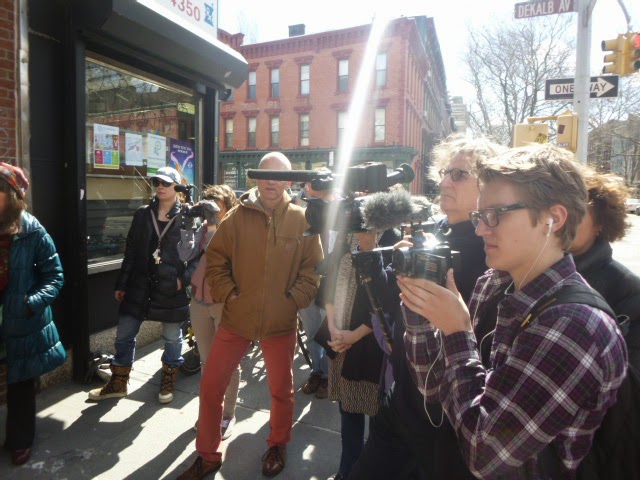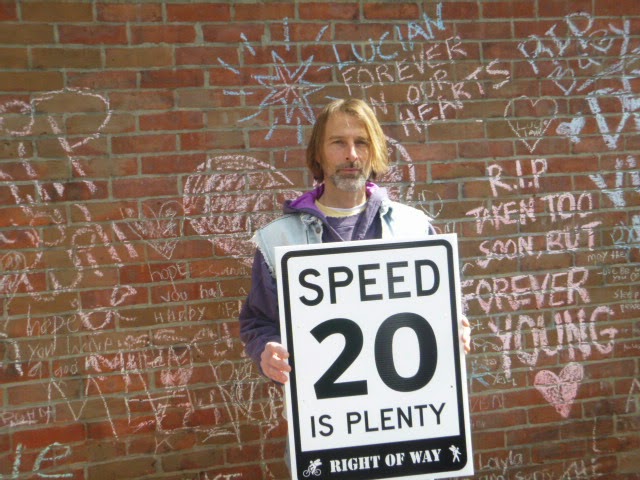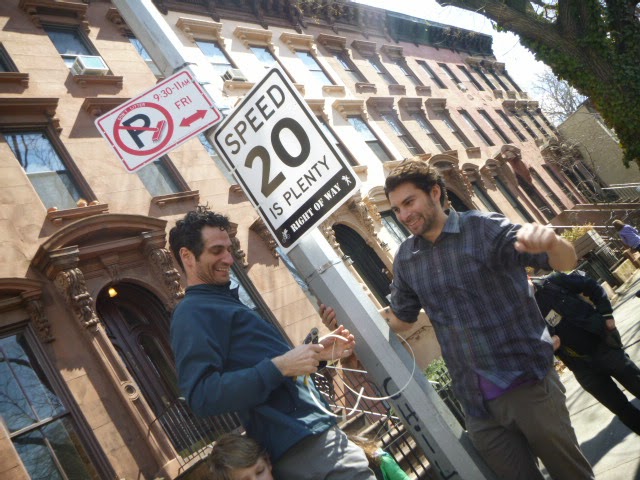This week, the movement for safer
streets took several amazing steps ahead.
Monday street activists met to talk
about ways to make Jay Street a safer place to ride, instead of a thoroughfare
of double parked cars, cops taking u turns, cars texting in bike lanes, and
congested streets.
Making
Brooklyn Safer writes:
We all know it: Jay Street is a mess. Pedestrians,
bicyclists, taxis and buses all compete for space on this chaotic, dangerous
street. But we can improve it! This community planning meeting will give you a
chance to imagine a better Jay Street, to mark the most dangerous local
intersections on a map and most important, to make your voice heard by decision
makers. – See more at: http://bikenyc.org/event/5843
 |
| A typical day of cars double parked on Jay Street, as they were on March 14th at lunch time. |
The event was a great success but it
starts with enforcement of current traffic laws, which today are being
neglected by police and drivers, making cycling through the area very, very
difficult. But the day after the event cars were again double parked all along Jay Street.
The movement continued on Saturday with the Right of Way Neighborhood Sign Raising Event.
The Right of Way press release declared:
10 NEIGHBORHOODS INSTALL ’20 IS PLENTY’ SIGNS ON STREETS WHERE THEY HAVE APPLIED FOR SLOW ZONES THAT HAVE BEEN REJECTED OR DELAYED
When: Saturday and Sunday, March 15th and 16th
Where: 10 Neighborhoods Across Four Boroughs
New York, New York: On Saturday and Sunday, March 15th and 16th, 10 communities that have applied for Neighborhood Slow Zones but have yet to receive any traffic calming infrastructure from the city will install their own “20 is Plenty” signs.
The rejection of Neighborhood Slow Zones grabbed headlines this week when the widow of Antonio Ramirez called on the DOT to reevaluate a Slow Zone that was denied two days before he was killed by a speeding driver.
Speed is the leading cause of traffic fatalities in NYC and
pedestrians are twice as likely to survive being struck by a car going 20mph as
30mph.
NYC allows
communities to apply for Neighborhood Slow Zones (NSZs). When
applications are approved, the zones are supposed to receive traffic calming
treatment including speed humps, road narrowing, daylighting, and 20mph speed
limits. As part of his historic Vision Zero initiative to eliminate traffic
fatalities in NYC, Mayor de Blasio has called for a rapid expansion of Neighborhood Slow
Zones.
“Yet there are
currently dozens of communities that have applied for Slow Zones and await
groundbreaking while people are dying,” said Keegan Stephan, an organizer with
Right of Way. “If you look at this recent slew of tragic deaths, they all
occurred in neighborhoods that had applied for slow zones – Noshat Nahian in
Jackson Heights, Coopers Stock on the Upper West Side, Lucian Merryweather in
Fort Greene, Sammy Cohen Eckstein in Park Slope, and so many more. These
communities knew their streets were dangerous and asked the city to fix them,
but were told no or not yet by the last administration.”
“These
rejections and delays are largely due to the last administration granting
community boards veto power over slow zones,” added Stephan. “Even one of the
Slow Zones slated to be installed this year, in Bed
Stuy, has since been rejected by the community board. This policy is not
required and is non-sensical for a public safety initiative. If the water
supply were poisoned and killing 250 people a year, would we ask for community
board approval to fix it? No. The DOT must use the mandate of Vision Zero
to revoke the veto power of community boards and begin installing life-saving
infrastructure today.”
“We are calling on the Mayor to
reverse these decisions and begin groundbreaking on all of these applied-for
slow zones today. That is the only way they will be guaranteed,” said Michael
Mintz of Right of Way. “As a grassroots, city-wide effort, this action also
demonstrates support for the DOT’s push to lower the speed limit across all
five boroughs, which we will advocate for in every way we can. But that
will take months of lobbying in Albany. In the meantime, we are calling on the
city to lower the speed limit on every street that it can, starting with these
slow zones.”
“Reducing speed
limits to 20mph is a great first step to making our streets safer for
everyone,” added Liz Patek, an organizer with Right of Way. “To make these slow
zones truly effective, it is imperative to redesign our streets with additional
traffic calming measures. Human error will occur, but streets designed according
to the principles of Sustainable Safety eliminate or greatly reduce the
consequences of human error. The cost of redesigning our streets is far
outweighed by the cost of losing even one life.”
A note from our
sponsor: “We’re so pleased to to help Right of Way get their message out with
our signs,” said Conrad Lumm of RoadTrafficSigns.com.
“Sometimes it falls to citizens to bring local governments’ attention to
pressing safety issues, and we applaud Right of Way for their creativity and
persistence.”
All signs generously donated by RoadTrafficSigns.com
The Right of Way facebook invite noted:
From Make Brooklyn Safer, who is organizing this installation of the week-end long,
city-wide demo:"Have your photo taken with a 20 is Plenty Sign and demand
that our city bring 20 mph to our residential streets. If the city won't, the
people will. WE CANNOT WAIT FOR SAFE
STREETS."
I
joined cyclists on a beautiful Saturday afternoon,
meeting everyone at the corner of Clermont and Dekalb in Fort Greet at 12:30. The street corner was the location where a
9-year-old boy was killed
by a car, while he
stood on the sidewalk, last November.
At the scene, Hilda Cohen, of Make Brooklyn Safer, stood with Keegan, of
Right of Way, in front of the memorial wall for the boy.
Cohen
explained the rationale for the event. We
know slow zones save lives. Speed and wreck
less driving effect all of us. Speed
kills. But our Ft Green application for slow zones was rejected. Sometimes it take the people to remind those
in power to do the right thing. So grab
a sign and take a picture of yourself with a twenty if plenty sign. We can’t wait for Brooklyn streets to become
safer. If the city refuses to move on
neighborhood requests for slow zones, then we will show them we can do this
ourselves.
Several
of us started taking pictures and posing with signs.
“I
love driving fast but in a neighborhood with kids, there can be no compromise (for
reducing fast driving)” explained one bystander, standing with his daughter. Several families were in attendance at the
event.
We posted signs up and down lovely Adelphi street.
"The argument has been, 'It's expensive to
put these signs up, it's going to take a lot of work and take a lot of
approval,'" I was quoted in Brooklyn News 12.
"We're here to say, 10 cyclists with some signs can put these signs up in
an afternoon and we know that this saves lives. That's the point."
 |
| By the end of the day, streets throughout Brooklyn were covered with 20 is plenty signs. |
 |
| And cars were not double parked in bike lanes. |





































































No comments:
Post a Comment